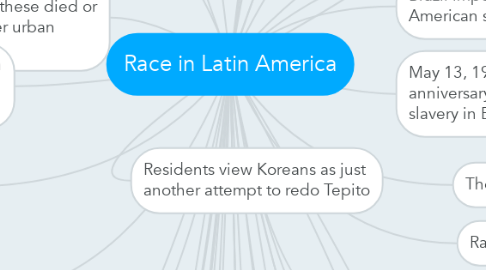Race in Latin America
par stephanie gonzalez


1. British were the first to experiment with the exporting of Chinese
2. The junta sent out an agent to China to study the importing Chinese coolies.
3. Forced recontracting began early in Cuba with the Reglamento of 1860
3.1. it obligated cooles who had completed their first eight years to recontact
3.2. recontracting further confirmed
4. Juan de la Rivas concluded that the coolie system was slavery
5. The Chilean invasion in 1880 created chaos along the coast in Peru
6. In Cuba, coolies had completed their contract and became naturalized as foreign residents.
7. "The enganche system in Peru gave way entirely to a free, or wage labor system, involving many Chinese until these died or moved out of agriculture into commerce and other urban occupations."
8. After the coolie trade, Chinese continued to go to Cuba and Peru, but large numbers migrated to Mexico
8.1. young Chinese immigrants began arriving on the West Coast of Mexico
9. By the end of Porfiriato in 1910, Chines population in Sonora was recorded in 1919 when they supplied the count of 6,078.
10. Koreans came to Mexico in the early 1990's hoping to gain a foothold in an embattled urban core
11. Residents view Koreans as just another attempt to redo Tepito
12. Tepitos are known as Mexico's supreme micro-capitalist with an instinct for survival
13. Tepito is now one of the only places in Mexico City where cocaine is sold.
13.1. The immigration law of November 1849 granted exclusive license for four years to planters
14. Gaspar Yanga
14.1. An African slave who led a rebellion against the Spanish colonial masters in the 16th century and fought off attempts to retake the settlement
15. Mexico's independence from Spain focus on building a national identity of mixed race.
16. Many of the countries black Mexicans are aware that their ancestors arrived in chains
17. National institutes of statistics geography was petitioned to include the Afro-Mexican population as a category in the next census
17.1. Official statistics don't recognize blacks as a separate ethnic group
17.2. as a result Afro-Mexicans say they have been left out of institutional programs
18. "The dreams of racism actually have their origin in ideologies of class, rather than in those of nation."
19. In all cases, equality and racial and cultural fusion are official and popular representations.
20. In other countries other voices have contested there images claiming discrimination against blacks and indigenous people.
21. Colombia has the largest black population in Latin America
22. The second organization had a wider influence because of its structure.
23. The context from which these movements emerged involved both national and transnational elements
24. Organizations look to other experiences and notions of blackness to inform their own positions
25. The progress of commission was uneven and involved conformation
25.1. By November 1992, black organizations delegates signed a document refusing to assist further meetings.
26. Zapatistas organize themselves to gain access to land, water, education, and healthcare.
27. Brazil imported more African American slaves than the US
28. May 13, 1988 was the 100th anniversary of the elimination of slavery in Brazil.
28.1. This celebration wasn't universal
28.1.1. "Many Afro-Brazilian groups staged actions and marches, issued denunciations and organized cultural events repudiating the 'farce of abolition."
